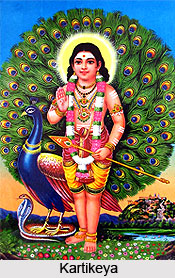 Kartikeya, the second son of Shiva and Parvati is also worshipped through various other names like Kumaraswami, Shanmukha or Shadanana, Subrahmanya, Skanda and Guha. In southern states of India, Kartikeya is a popular deity and better known as Murugan.
Kartikeya, the second son of Shiva and Parvati is also worshipped through various other names like Kumaraswami, Shanmukha or Shadanana, Subrahmanya, Skanda and Guha. In southern states of India, Kartikeya is a popular deity and better known as Murugan.
Kartikeya is the war god. He was created by all gods to lead the heavenly hosts and to destroy the demons. He is masculine and powerful among gods. He is the deity of perfection. When Ganesha removes all the obstacles, Kartikeya bestows the devotees with all spiritual power, especially the power of knowledge.
Kartikeya is known as Shadanana or Shanmukha because he has six heads. As he was breast-fed by six Karittika deities, he obtained those six faces. Kartikeya`s five extra faces represent the five senses of human being. The six faces also indicate that he can see in all directions, which is an important attribute to face the blow from all directions during the war. Karikeya is called Subhramanya because he is omniscient. Since he gathered a huge army he is also known as Mahasena. As he captained the divine forces in the fight with the Asuras(demons), he is also called as Senani, which means `Commander`. Since Kartikeya was born from the life force that slipped from Shiva, he is known as Skanda. The peacock is his mount; hence he is called as Sikhivahana. Kartikeya is depicted as an ever-youthful person and that is why known as Kumara, which also means one who kill evil persons. He is also worshipped in the name of Guha.
Kartikeya resurrected the path of virtue by killing the demons Tarakasura and Shurapadma who were harassing the common men thus he protected his devotees from enemies. The vehicle of the god is peacock, which destroys harmful serpents, which symbolize the negative desires and harmful ego of people. In one hand Kartikeya carries a spear called Sakti that symbolizes the destruction of negative aspects in human being.
Kartikeya thus shows his devotees the way of reaching perfection in life.



















